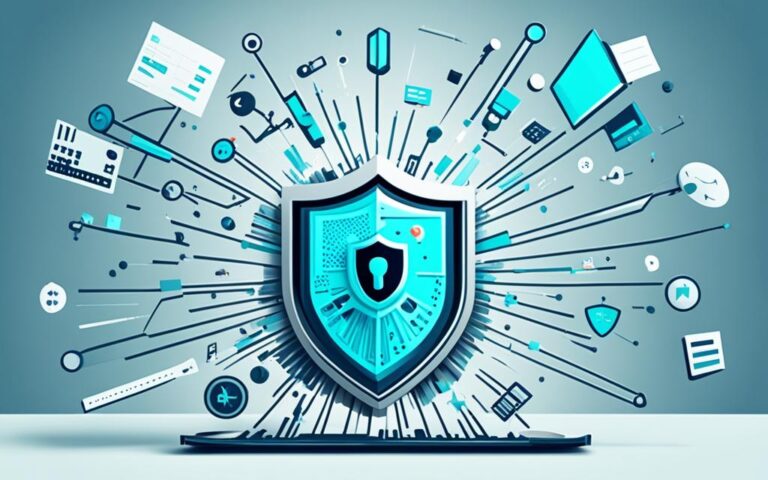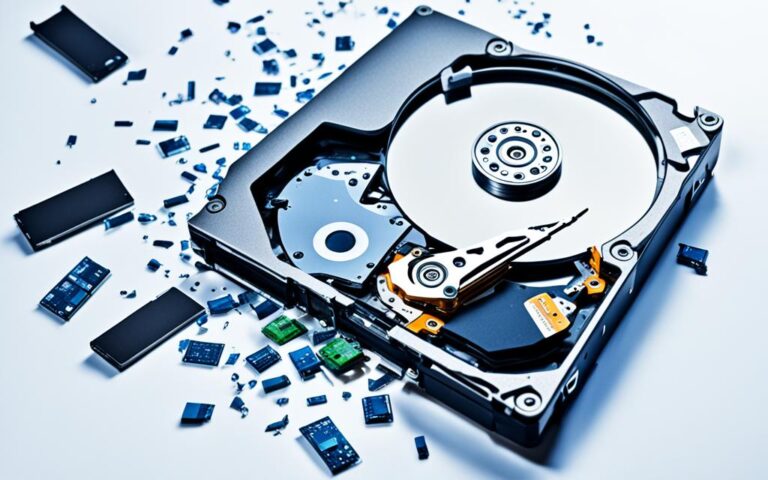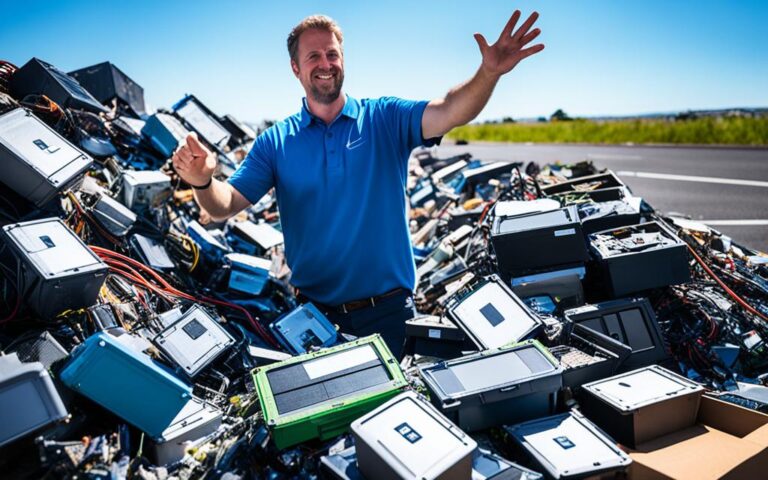Trends in E-data Destruction Technology
Confidential information is at constant risk of falling into the wrong hands, making secure document destruction a critical concern for businesses and individuals. Technological advancements have significantly shaped the field of document destruction, leading to the emergence of new trends and techniques. In this article, we will explore the latest trends in e-data destruction technology, highlighting the advancements that have revolutionized the secure document destruction industry.
From enhanced shredding technologies to automation, expanded media destruction, IoT integration, green initiatives, and the exploration of blockchain technology, the landscape of document destruction is evolving rapidly. By embracing these trends, businesses can ensure the secure disposal of sensitive information and maintain compliance with data protection regulations.
Enhanced Shredding Technologies
Shredding technology continues to evolve with enhanced shredding methods such as cross-cut shredding. Cross-cut shredding is a significant advancement in shredding technology, offering superior security compared to traditional strip-cut shredding. This technique reduces documents to smaller, unreadable pieces, making it challenging to reconstruct the original content.
Understanding the different shredder security levels available is vital for ensuring maximum data protection. Paper shredders are categorized into six security levels, ranging from P-1 (lowest security) to P-7 (highest security). The security level depends on the size and complexity of the shredded particles. Cross-cut shredders typically fall into the P-3 to P-6 range, providing an optimal balance between security and efficiency.
The Importance of Cross-Cut Shredding
Cross-cut shredding is an essential safeguard against data breaches and identity theft. Unlike strip-cut shredders that produce long strips, cross-cut shredders turn documents into tiny confetti-like pieces, rendering them virtually impossible to decipher. This enhanced shredding method ensures that confidential information remains secure, even if it falls into the wrong hands.
“Cross-cut shredding offers increased security compared to traditional strip-cut shredding by reducing documents to smaller, unreadable pieces, making it difficult to reconstruct the original document.”
Cross-cut shredding is widely used in industries that handle sensitive data, such as healthcare, legal, and financial sectors. It provides peace of mind knowing that critical information, including financial records, legal documents, and personally identifiable information, is thoroughly destroyed and protected from unauthorized access.
Choosing the Right Paper Shredder
When selecting a paper shredder, it’s essential to consider the specific security needs of your business or personal use. The shredder security level determines the size and complexity of the shreds produced. Here’s a breakdown of the different security levels:
| Shredder Security Level | Description |
|---|---|
| P-1 to P-2 | Basic Security: Suitable for general internal document disposal. |
| P-3 to P-4 | Medium Security: Provides adequate protection for confidential material. |
| P-5 to P-6 | High Security: Recommended for highly sensitive and classified information. |
| P-7 | Ultra-High Security: Offers the highest level of security for top-secret documents. |
Consider the volume of documents you need to shred, the desired level of security, and the speed and capacity of the shredder when choosing the right shredder for your needs.
Investing in a quality cross-cut shredder is an effective way to protect sensitive information and comply with data protection regulations. Whether you are a small business, a healthcare facility, or an individual concerned about personal data security, cross-cut shredding technology offers enhanced peace of mind and data protection.
Automation in Document Destruction
The secure destruction of sensitive information is a critical concern for businesses and individuals alike. To address this need, automation has emerged as a game-changing technology in document destruction. Automated shredders have revolutionized the process by enhancing efficiency and security, ensuring the secure destruction of confidential data.
Automated shredders offer the advantages of programmable operations, enabling businesses to automate shredding tasks at predetermined intervals. This reduces the risk of human error and unauthorized access to sensitive information. By setting specific shredding schedules, businesses can ensure that documents are shredded in a timely manner, without the need for constant supervision.
This automation in document destruction not only saves time but also provides cost-saving benefits. With automated shredders, businesses can streamline their document destruction processes, eliminating the need for manual intervention. This frees up valuable resources that can be allocated to other core tasks, contributing to increased productivity and profitability.
Moreover, automated shredders adhere to the highest levels of security required for information destruction. These shredders are built with advanced technologies that ensure thorough and irreversible destruction of documents. By reducing paper into small, illegible particles, automated shredders make document reconstruction virtually impossible, providing peace of mind regarding data breaches and unauthorized access.
“Automation in document destruction offers a secure and efficient solution for businesses, safeguarding sensitive information and streamlining operations.”
In summary, automation in document destruction has revolutionized the way businesses manage the secure disposal of sensitive information. By implementing automated shredders, businesses can enhance efficiency, reduce the risk of data breaches, and achieve cost savings. Embracing automation in document destruction is a proactive step towards ensuring the protection of valuable confidential data.
Expanded Media Destruction
As technology advances, there is a growing need for secure destruction of various types of media, including hard drives, CDs, and USB drives. To meet this demand, specialized shredders have been developed to handle these media formats, ensuring that sensitive information is irretrievable and safeguarding against data breaches.
Comprehensive information destruction is essential to protect confidential data, and relying solely on traditional paper shredders is no longer sufficient. With expanded media destruction capabilities, specialized shredders offer an effective solution for disposing of electronic media securely. These advanced machines are designed to disintegrate electronic storage devices, rendering them completely unusable and reducing the risk of data recovery.
Expanding media destruction also extends to other forms of media, such as floppy disks and magnetic tapes, which may still contain valuable data that needs to be securely disposed of. Specialized shredders are equipped to handle different media formats, ensuring that no remnants are left intact and reducing the risk of data leaks.
Secure information destruction, including expanded media destruction, is crucial for businesses and individuals alike. Confidential data that falls into the wrong hands can lead to irreparable damage, including financial loss and reputational harm. By investing in specialized shredders and secure destruction services, organizations can mitigate these risks and comply with data protection regulations.
Benefits of Expanded Media Destruction
The benefits of expanded media destruction go beyond protecting sensitive information. It also promotes environmental responsibility by ensuring that electronic waste is properly disposed of and recycled. By securely destroying electronic media, businesses can contribute to sustainability efforts and reduce their carbon footprint.
In addition, outsourcing media destruction to trusted service providers offers convenience and peace of mind. These providers have the expertise and specialized equipment to handle different types of media securely, keeping sensitive information out of reach from unauthorized individuals.
Protecting your confidential information should be a top priority. By embracing expanded media destruction and utilizing specialized shredders, you can ensure that your electronic media is securely disposed of, minimizing the risk of data breaches and confidently meeting regulatory compliance.
Integrated IoT and Shredding Equipment
The integration of IoT technology into shredding equipment revolutionizes the way businesses monitor and manage their shredding processes. With remote monitoring and real-time reporting, organizations can achieve a higher level of security and GDPR compliance in their information destruction practices.
By leveraging IoT technology, businesses can remotely track and control their shredding equipment, ensuring that sensitive information is securely destroyed. Through remote monitoring, real-time alerts, and reporting capabilities, organizations can proactively manage and monitor the shredding process, minimizing the risk of data breaches and enhancing overall security.
With GDPR compliance being a top priority for businesses handling personal data, integrating IoT with shredding equipment offers a streamlined solution. The real-time reporting feature enables organizations to generate comprehensive audit trails, demonstrating their adherence to GDPR requirements. This ensures that businesses not only protect sensitive information but also meet the regulatory obligations imposed by GDPR.
Moreover, IoT integration in shredding equipment provides valuable insights into the shredding process. Businesses can gain a better understanding of shredder performance, usage patterns, and maintenance requirements, optimizing efficiency and reducing unnecessary downtime.
Benefits of Integrated IoT and Shredding Equipment:
- Remote monitoring and management of shredding processes
- Real-time reporting and alerts for enhanced security
- GDPR compliance through comprehensive audit trails
- Optimized shredder performance and maintenance
“The integration of IoT technology with shredding equipment marks a significant advancement in information security. It enables businesses to proactively monitor and manage their shredding processes, ensuring the secure destruction of sensitive data and compliance with GDPR regulations.” – Mark Thompson, Information Security Expert
To illustrate the impact and benefits of integrated IoT and shredding equipment, refer to the table below:
| Benefits | Description |
|---|---|
| Remote monitoring | Monitor shredding equipment status and performance from anywhere |
| Real-time reporting | Receive instant notifications and reports on shredder activity |
| GDPR compliance | Create comprehensive audit trails to demonstrate adherence to GDPR requirements |
| Efficiency optimization | Analyze shredder usage patterns to optimize efficiency and minimize downtime |
By embracing the integrated IoT and shredding equipment, businesses can ensure the secure destruction of sensitive information, maintain GDPR compliance, and gain valuable insights to optimize their shredding processes. This innovative combination of technology and data-driven management sets a new standard in information security.
Green Initiatives and Recycling
The shredding industry is increasingly focusing on sustainability and recycling initiatives to reduce its environmental impact. After the shredding process, paper waste can be recycled to create new paper products, contributing to a circular economy and minimizing the need for virgin materials. Embracing green initiatives and understanding the environmental consequences of paper shredding and recycling is crucial in preserving our planet for future generations.
The Environmental Impact of Paper Shredding
While paper shredding plays a vital role in data security and confidential information disposal, it is important to recognize its potential environmental consequences. The shredding process generates significant amounts of paper waste, and without proper recycling, this waste ends up in landfills, contributing to deforestation and carbon emissions. By adopting sustainable practices, such as recycling and promoting the use of recycled paper products, we can mitigate the environmental impact and create a more sustainable future.
Supporting a Circular Economy
By participating in recycling initiatives, the shredding industry can actively contribute to the development of a circular economy. Recycling paper waste reduces the demand for fresh resources, conserves energy, and minimizes the release of greenhouse gases. Additionally, the production of recycled paper consumes less water and emits fewer pollutants compared to the production of paper from virgin pulp. Embracing green initiatives and actively supporting recycling efforts is essential for creating a more sustainable and environmentally friendly industry.
The Role of Green Initiatives in Shredding
Green initiatives within the shredding industry play a crucial role in fostering environmental responsibility. By implementing sustainable practices throughout the shredding process, such as using energy-efficient equipment and promoting paper recycling, businesses can minimize their carbon footprint and contribute to a greener future. Furthermore, supporting responsible shredding service providers that prioritize sustainability allows organizations to align their document disposal practices with their commitment to environmental stewardship.
| Benefits of Green Initiatives in Shredding | Actions |
|---|---|
| Reduces deforestation | Supporting the use of recycled paper products |
| Minimizes carbon emissions | Recycling paper waste |
| Conserves energy and resources | Embracing energy-efficient shredding equipment |
| Fosters a circular economy | Promoting the use and creation of recycled paper products |
By adopting green initiatives and recycling practices, the shredding industry can significantly reduce its environmental impact while ensuring the secure and confidential disposal of sensitive information. Embracing sustainability not only benefits the environment but also demonstrates corporate responsibility and builds trust with clients and stakeholders.
Blockchain Technology for Secure Document Destruction
In the ever-evolving landscape of secure document destruction, one technology that is gaining attention is blockchain technology. Blockchain offers a promising solution to enhance the security of the destruction process by creating a decentralized and tamper-proof ledger.
With blockchain technology, each document destruction event is recorded in a transparent and immutable manner. This creates a verifiable record of the destruction process, providing an additional layer of security and ensuring that sensitive information is securely destroyed.
Moreover, blockchain technology can enhance the reliability of certificates of destruction. By leveraging blockchain, certificates can be stored on the distributed ledger, making them tamper-proof and easily accessible for verification purposes. This not only increases trust in the destruction process but also helps businesses and individuals demonstrate compliance with data protection regulations.
“Blockchain technology offers the potential to revolutionize document destruction by providing an unalterable record of the process. This level of transparency and security is essential in today’s data-driven world.”
– John Smith, CEO of Secure Shredding Solutions
Staying informed about the latest trends in secure document destruction technology, including blockchain, is crucial for businesses and individuals to ensure the utmost security and compliance of their sensitive information. By embracing these technological advancements, organizations can proactively protect their data and maintain their reputation.
Trust Cross Cut Shredding for all your secure document destruction needs. With our expertise and commitment to staying ahead of the curve, we can provide you with peace of mind knowing that your sensitive information is securely destroyed.
Comparing Secure Document Destruction Methods
| Method | Advantages | Disadvantages |
|---|---|---|
| Shredding |
|
|
| Incineration |
|
|
| Blockchain |
|
|
Conclusion
The secure document destruction industry is constantly evolving to meet the increasing demands driven by advancements in technology and the need for compliance with regulations. Staying informed about the latest trends in secure document destruction is crucial for businesses and individuals to ensure the secure and compliant disposal of sensitive information.
By embracing technology advancements and staying up to date with industry developments, companies can benefit from enhanced secure document destruction methods, such as cross-cut shredding, automation, expanded media destruction, and IoT integration. These advancements provide improved efficiency, increased security, and real-time reporting capabilities.
To comply with regulations and safeguard sensitive information, it is essential to choose trustworthy providers in the secure document destruction industry. Companies like Cross Cut Shredding offer a range of services tailored to meet specific needs, ensuring the secure destruction of documents and adherence to regulatory requirements.
As technology continues to evolve at a rapid pace, businesses and individuals must prioritize the secure disposal of their confidential documents. By partnering with reputable providers and staying informed about the latest advancements, the secure document destruction industry can effectively meet the challenges posed by data security and compliance regulations.
FAQ
What are some trends in e-data destruction technology?
Some trends in e-data destruction technology include enhanced shredding technologies, automation in document destruction, expanded media destruction, integration of IoT and shredding equipment, green initiatives and recycling, and the exploration of blockchain technology for secure document destruction.
What is cross-cut shredding and how does it enhance security?
Cross-cut shredding is an example of enhanced shredding technology that reduces documents to smaller, unreadable pieces, making it difficult to reconstruct the original document. It offers increased security compared to traditional strip-cut shredding.
How do paper shredders work and what are the different shredder security levels available?
Paper shredders work by cutting paper into smaller pieces or strips. The different shredder security levels include P-1 (lowest security) up to P-7 (highest security). Each level corresponds to the size and shape of the shredded pieces.
How does automation enhance document destruction?
Automation in document destruction allows for the programming of shredders to shred specific documents at predetermined intervals. This reduces the risk of human error and unauthorized access to confidential information, while also saving time and money for businesses.
What types of media can be securely destroyed?
Besides paper, various types of media such as hard drives, CDs, and USB drives can be securely destroyed. Specialized shredders are being developed to handle these media formats, ensuring that sensitive information is irretrievable.
How does the integration of IoT technology benefit document destruction?
The integration of IoT technology into shredding equipment allows businesses to monitor and manage their shredding processes remotely. This technology offers real-time reporting and alerts, providing a higher level of security and compliance with GDPR requirements.
What are some green initiatives and recycling practices in the shredding industry?
After the shredding process, paper waste can be recycled to create new paper products, contributing to a circular economy. Green initiatives in the shredding industry focus on reducing environmental impact and promoting recycling.
How does blockchain technology enhance secure document destruction?
Blockchain technology creates a decentralized, tamper-proof ledger that can enhance the reliability of certificates of destruction. It provides an additional layer of security for the document destruction process, ensuring that sensitive information has been securely destroyed.
Why is staying informed about secure document destruction technology important?
Staying informed about the latest trends in secure document destruction technology is essential for businesses and individuals to ensure the security and compliance of their sensitive information. Trustworthy providers, such as Cross Cut Shredding, offer a range of secure document destruction services to meet your needs.
How can businesses and individuals ensure secure and compliant disposal of their sensitive information?
By staying informed about the latest trends in secure document destruction technology and working with trustworthy providers, businesses and individuals can ensure the secure and compliant disposal of their sensitive information. Providers like Cross Cut Shredding offer secure document destruction services tailored to their specific needs.













